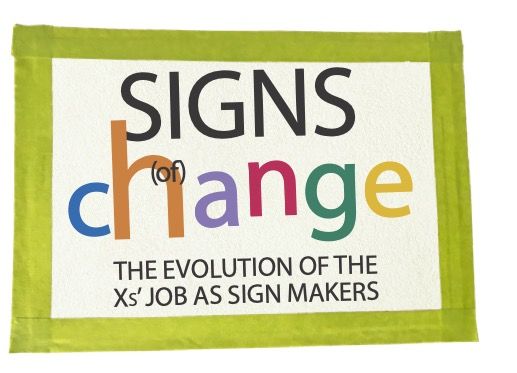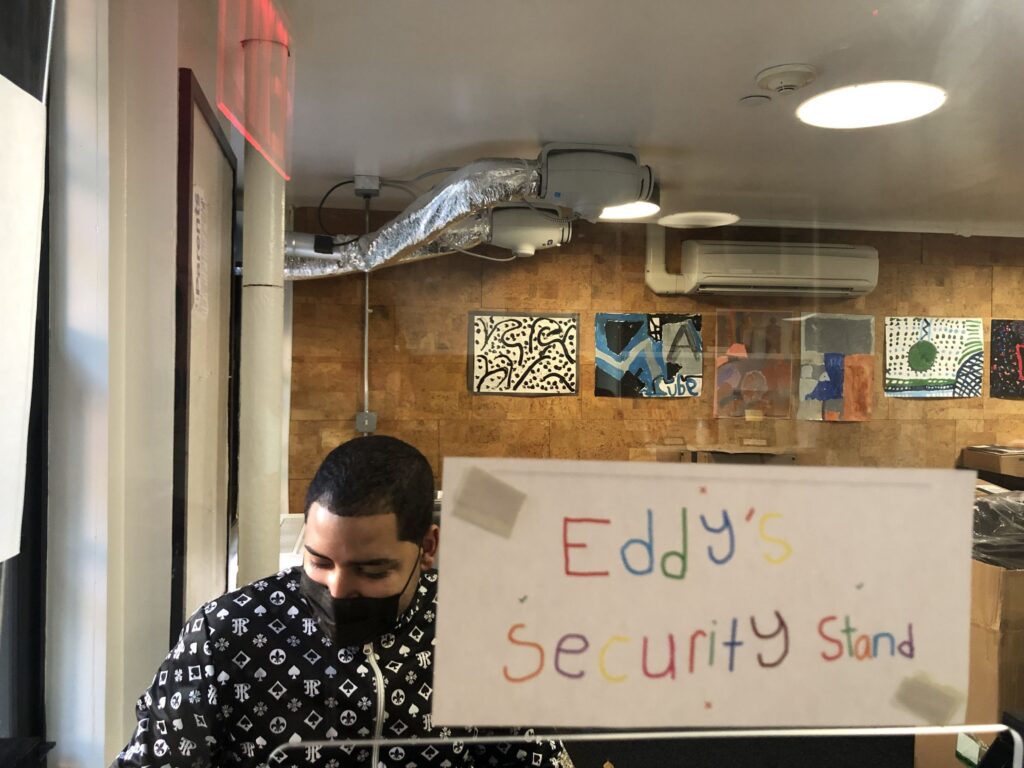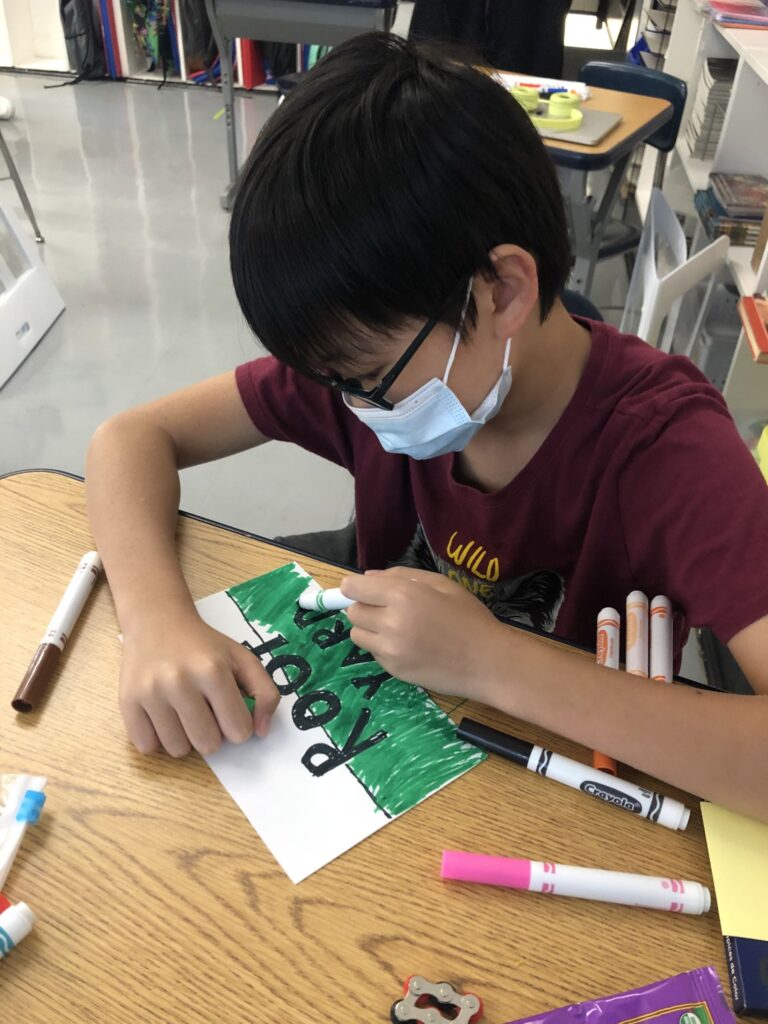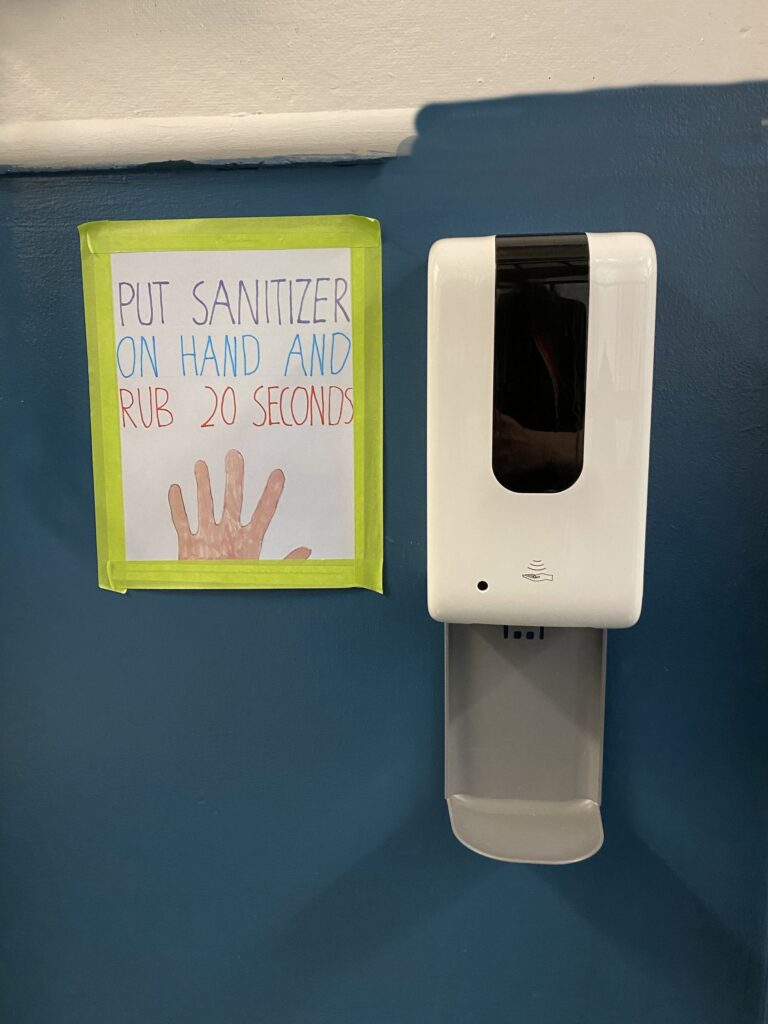Signs (of) Change: The Evolution of the Xs’ Job as Sign Makers
8/3/2021

On a typical first day of school in September, the hallways are filled with the rush of students greeting their friends after a long summer break, teachers leading their new Groups to their Rooms, and more than one confused parent or staff member trying to navigate the seven brownstones of City and Country School in search of the correct office or meeting room. Unlike most schools, C&C does not have permanent signs on classroom doors or in hallways to help orient visitors in the space. This charming chaos is by design: The Xs, the Sign Makers of the School, have not yet put up any wayfinding signage in the buildings, and the difficulty navigating in these early days of the year serves to demonstrate how critical the Xs’ Job is to the overall functioning of the School.
The pandemic protocols that accompanied the return to in-person instruction made some changes necessary. With the Xs not beginning in-person school until late September, and with a strong need to limit unnecessary movement within the buildings for safety reasons, the Xs team faced the first of many questions about how to maintain the essence of the Job as Sign Makers while adapting to the realities and opportunities presented by the pandemic.

The Xs teaching team—Molly Lippman (XsM Group Teacher), Gee Roldan (XsG Group Teacher), and Chloe Cole (Xs Associate Teacher)—began thinking about these changes during the summer, well before any children arrived at school or logged on to their first remote class. Coming out of their IXs Job of running the School Store, the Xs were primed to approach their Job as Sign Makers as a business. Usually this process would kick off with a number of Super Group meetings (that is, with both Xs Groups) to organize, make to-do lists, and break into committees focused on key tasks such as branding, sticky stuff, sign materials, and pricing. Every year, the 12th and 13th Street buildings are divided up, and each is assigned to one of the Xs Groups. There is normally a great deal of back and forth among students to coordinate their work on these two spaces, especially on the big questions of branding and visual identity. This year, however, there were a number of logistical challenges—among these, that the XsG and XsM were not in-person on the same days of the week, and that some students were participating in a fully remote program.

Full-color signs or keep them all black and white?
“XsM” or “XsM Room” on the classroom door? The Xs team knew that numerous decisions like these, which are usually made by students quite literally running back and forth between rooms, would take on many levels of complexity if they had to be scheduled and conducted via Zoom or email. The teachers reflected: If students and staff are not moving between buildings in the same ways that they usually do, does the Sign Makers’ process need to be “business as usual”? The important elements of the Job—collaborative work, creativity, research, and problem-solving—would remain intact even if the Groups recentered some decision-making in the individual Xs Groups, rather than in the larger Super Group. While the process of determining key tasks and responsibilities would remain a shared Xs experience, each Group was given more autonomy over the decisions for their individual buildings.
A sense of excitement grew. With fewer Super Group decisions before them, students were able to move more quickly into creating the room and wayfinding signs and going deeper into their work as Sign Makers. The creative element of producing personalized hand-made signage is made more meaningful each year by the Xs’ fall exploration of the history of writing, the evolution of various scripts, and the impact of writing as a technology that spurs growth and change. Like the people they studied from long ago and far away, our students’ innovations this year reflected their own lived experiences.
Sign Making in the Digital Age

In the fall, the remote Xs’ Job responsibilities mirrored those of their in-person peers: They were assigned rooms, they created handmade signs on paper, and they scanned and emailed in their signs to be printed and hung up at school. Following Winter Break, Molly, Gee, and Chloe were thinking about ways to keep their fully remote students engaged, and the conversations with students turned to: What can we do in this digital space? “We’re on email all the time,” said Chloe, “so we wanted to explore how we can use signs in this context. Email has long been the primary way faculty and staff communicate, but this year, the same holds true for many students.”
Their foray into digital signage started slowly. The students drew signs offline (as they had done with room signs), scanned or took a photos of the signs, and then added the images as email signatures. At the same time, they were learning to use Photoshop in Art/Shop/Computer class, including exploring how to make GIFs—animated images commonplace across the internet and widely used on social media. They began asking if they could start using these new skills to make digital email signatures rather than hand-drawn ones. “C&C has a tradition of making all signs by hand—is this something we could depart from? This was the big question,” said Chloe. And yet, the core of C&C’s approach is to be responsive to students—what they’re enthusiastic about and what they want to pursue. “My Xs were spending their time outside of class working on creating digital images, experimenting with techniques, and teaching each other the skills and tricks they had picked up. Clearly they were excited about this!” said Chloe. The students soon began offering a new product, this one fully digital: personalized GIF email signatures.
What does this addition mean to the Xs’ Job? “We’re always trying to make connections between what the students are learning and the outside world. It’s easy for them to see signs and symbols in digital spaces like websites and online ads,” Chloe shared. One feature of the Jobs Program is the way it helps students build skills that are useful beyond the classroom. As the students work with Photoshop, they are not only acquiring an important technical skill, but they are also learning about graphic design, which is so fundamental to the physical and digital signs they see all around them.

Going Deeper
The Xs’ Job is about more than just orienting and communicating inside the physical and digital spaces of the School. It is also closely tied to the Xs’ curriculum, and in particular, their Studies of writing systems across time. As they delved more deeply into the role that writing had in communications, power, and religion in the Ancient World, the Xs connected strongly with the ways that signage is related to action around social and political issues today. “Throughout the year, the Xs have been talking about current events—organically and sometimes in more directed ways when things have bubbled up in the news. Community Discussions about women’s rights, LGBTQ+ rights, Black Lives Matter, climate change, and the presidential election have been the topics the Xs have consistently circled back to,” said Gee. “They have also been creating signs with messages that they hope will inspire change.” In addition to appearing in the news, many of these topics came up organically as Xs read short stories in Writer’s Workshop or creation myths in Book Group; for example, the concepts of power, socio-economic class, religion, and gender roles emerged when reading ancient Egyptian myths and in their historical fiction book, Eye of the Moon, by Dianne Hofmeyr.
The Xs have also been looking for ways they can have a positive impact on the community. In the winter, they did this by making signs encouraging students, faculty, and staff to stay positive and keep going, an especially powerful message to see in the hallways as we passed the one-year anniversary of when the pandemic began to affect our lives. “In January, our Community Discussions and metacognition conversations (facilitated by Xs and XIs Learning Specialist Michele Bloom) focused on how to check-in with ourselves—the importance of being our best selves, navigating distractions, putting a positive spin on negative situations,” Gee shared. “I saw an opportunity to have the Xs create message signs—ones that would inspire people in our community to stay positive and motivated, in addition to the message signs that express a call for change. This gave students more creative freedom: Xs could play around with color, fonts, and images in an entirely different way from the informational print signs and safety signs.”
The Xs’ Job this year has adapted and grown in response to the changing demands of the pandemic, but it continues to serve its essential purposes: to build Groupness and collaboration skills; to serve the larger school community; to give students transparency into and ownership over a complete process; and to allow the Xs to connect their own experiences here and now with the daily lives of the people they study from long ago and far away.
NEW PRODUCT ALERT: GIF SIGNATURES
This year’s unique format, with C&C students, teachers, and staff in different combinations of in-person and remote time, put more emphasis than ever on C&C’s digital spaces. Xs picture signs, which are usually commissioned for offices and classrooms, are a highlight of the year—a source of pride among the students who make them and excitement for those who order them. With many staff members working remotely this year and onsite faculty and staff using spaces around the school much differently, how could the Xs recapture and spread the creativity and joy that these signs bring? The remote students in the XsMC came up with a brilliant idea: If people aren’t ordering office signs, how about digital signs for their email signatures? Chloe worked with the XsMC—the Xs’ fully remote students—to help them create personalized GIFs that could be ordered by community members for use in their email signatures.
MIDDLE SCHOOL JOBS DURING THE PANDEMIC
By Ayesha Long, Director of Middle School
The Jobs Program has been part of the Middle School since its founding. Traditionally, the VIIIs’ Job is to run the Post Office, a responsibility that includes taking daily attendance, collecting and distributing postcards and letters, and making and selling stamps and other Post Office items. They also do Round Robins, visiting classrooms to share important school-wide announcements. The IXs are in charge of the School Store, selling needed materials to classrooms, offices, and visitors. The Xs make signs, both to label the spaces in the buildings and in response to needs expressed by faculty and staff.
This year, the Jobs Program is still alive and well in the Middle School—with slight adaptations, of course. For the VIIIs and their Post Office, these changes are visible in exciting ways. Round Robins are now conducted virtually, by going into Zoom rooms to give announcements and by sharing Middle School-specific reminders at the Assemblies.
The IXs’ School Store—the Store of the Ox—still sells many normal school staples: small whiteboards, clay, paint, pencils, and highlighters. This year, they also sell an assortment of health and safety items needed in response to COVID-19, including hand sanitizer and customized masks—all through a website they created. And though the 12th Street Store space can only be used for storage, rather than as a place customers can visit to make purchases, the IXs are able to provide contactless delivery to classrooms and offices on 12th Street, partnering with the VIIIs to deliver to 13th Street customers.
The Xs, our Sign Makers, always play a critical role in the School by labeling spaces with words and pictures. This year, they have also been instrumental in reminding us of the safety measures we need to follow, from maintaining social distancing and masking to following proper hand-washing techniques. They are also offering new products, from personalized GIFs for our email signatures to the motivational posters now hanging in our hallways.
Although the precise responsibilities and logistics of the Middle School Jobs have changed during the pandemic, the core of the program has remained: to engage children in hands-on experiences that have a meaningful role in the functioning of the School and to allow them to gain understanding of a complex system by immersing themselves in the full, visible process of designing and implementing it.
Click here to read the full article, including images and interactive links, in Issue IV of our magazine, Works in Progress.
